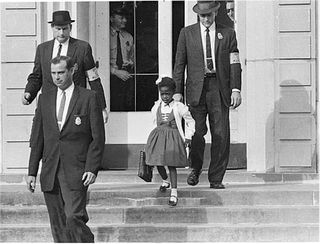Trauma
Our Uncomfortable Relationship With a Connected History
Understanding the tension between the shared history of different groups.
Posted February 20, 2018

It should’ve been an uneventful school day like any other—youngsters excitedly finding their seats in class and parents hurriedly dropping kids off to congenial teachers. Instead, a crowd formed outside of New Orleans’ William Frantz Elementary School on the morning of November 14, 1960 to protest the enrollment of a little girl being escorted by four US Marshals to her first day of school. Six-year-old Ruby Bridges was making history as the first African American student to integrate an elementary school in the segregated South. She shouldn’t have been required to pass a special exam to attend the elementary school located blocks from her house instead of the segregated Black school miles away. But she did. She shouldn’t have witnessed adults threatening to poison her, showing Black dolls in coffins, or pulling their children from the school in droves. But they did. The one teacher, Ms. Henry, who welcomed the opportunity to teach Ruby in a class that no other students would attend the entire year, shouldn’t have been released from her contract at the end of the year. But she was. This is our history and it makes us uncomfortable.
History is a collection of interwoven stories coalescing to create the foundation for how we understand ourselves and the world around us. In many ways, history gives our lives meaning. Yet, we can decide which story we choose to tell ourselves and our children. When told accurately, these stories can spark self-appreciation and a humble awareness of other’s stories. When the clear truths of these stories are denied or forgotten, a dangerous distortion can occur and compel us to fight against our own best interests because we can’t fully appreciate how connected our stories are to others. Harnessing history to illuminate how these shared stories have the power to keep us safe and give our lives meaning in an increasingly connected world may be one of the most necessary next steps.
Harness History for Healing
The past shows up in unexpected ways. Ask any therapist whether our childhood relationships impact how we deal with stress, bosses, or romantic partners today. A sophisticated answer will reveal links between how we connected with our caregivers as children and our body and brain’s responses to perceived threat or the strategies we use to find love and connection. What may be most interesting is the narrative that shapes our identity—that sense of self—is filled with messages from others about our worth, potential, ability to handle challenges and a litany of other deeply personal ideas about ourselves. These principles about how we blossom into who we are as individuals extend to how entire communities develop narratives about their place in society.
There’s no narrative more powerful than of a community who has overcome oppression. From the Holocaust to slavery in the United States to genocide and displacement of Native Americans, recent research shows the generational impacts of these historical traumas on communities. Biologically, the epigenetics movement suggests that increased sensitivity to stress can be inherited from parents and grandparents who experienced the original historical trauma. Messages from parents and grandparents about facing discrimination or handling prejudice create a narrative for how young people understand their role in society and ways to stay safe. These messages are reinforced by actual biases from those in power that lead to disproportionate contact with law enforcement or stereotypes that create blind spots when deciding to hire someone. Naturally, tension builds when a member of the oppressed group is treated in a manner that seems to reflect these messages, a counter-narrative filled with stories that are incomplete or untrue. More importantly, the counter-narrative of those who have power is most frustrating because it conflicts with the narrative many from the oppressed groups have of themselves.
The problem and promise of this tension are that the solution begins with making the invisible visible. Imagine someone jumps in front of you in line at the store. You run through a number of scenarios in your mind for how to express the depth of your anger until the person turns around and says, “sorry I didn’t see you there. I’ll hop behind you.” The anger quickly deflates because an injustice was acknowledged and an adjustment was made to reverse the damage. The invisible counter-narratives that deny the impact of historical trauma on groups of people and fail to use this acknowledgment as the spark to adjust and reverse the damage only increase tension. As social science has illuminated these invisible counter-narratives through professional development training on implicit bias or scientifically documenting the impact of historical trauma on people of color, what becomes visible is a more accurate narrative that reflects our collective stories. Equally important, the visible acknowledgment and adjustment through interventions facilitate individual and community healing.
Harness History for Growth
Isaac Newton’s assessment that, “if I have seen further than others, it is by standing on the shoulders of giants” is only magnified in an era that has enhanced our ability to connect with history and each other through technology. The stories that were once shared through oral tradition or in textbooks curated by those in power are either reinforced or challenged on social media—sparking a groundswell of support or protest that can translate into a network of people with the ability to elevate awareness around why certain lives matter or gain momentum to elect a president. Joshua Cooper Ramo proposes connectivity is such a central aspect of the past three decades that we should categorize our current time as the “Network Age” with implications comparable to other pivotal ages such as the Enlightenment or Renaissance. Research shows that our electronically connected world has created some of the greatest echo chambers in modern history and in many instances interferes with opportunities to connect with the stories of others who differ from us. Reframing how we see others stories may transform our discomfort with history to an openness for connecting with different stories because it becomes clear that connection sprouts pathways for our personal growth.
Reframing is a psychological tool that allows us to shift our mindset in a manner that broadens our perspectives and provides new opportunities to connect with others. In Muzafer Sherif’s classic Robber’s Cave experiment, he transformed two groups of boys who were conditioned to compete with one another and vehemently dislike the other group into a relatively unified group by the end of the experiment. The catalyst for the shift was a problem caused by someone outside the two groups that forced the boys to work together. Once they learned their group had a vested interest in the success of the other group, their perspectives of the other group shifted and it became substantially easier for them to connect.
When a community’s narrative is filled with traumatic experiences that continue to impact how members of that community protect themselves and decide to contribute their talents to others, acknowledging this history and making necessary adjustments give those within and outside the community opportunities that otherwise would be missed. Opportunities to provide treatment for traumatic stress reactions instead of suspension or prison for misunderstood behaviors. Opportunities to create avenues to succeed for brilliant children who may one day contribute something to society as consequential as the iPhone, but are currently pre-occupied with helping their parents pay for bills and resisting the lure of quick money through unlawful means. Opportunities to shift perspectives about the history of different communities and understand how intertwined these histories are, particularly given the importance of modern-day connectivity through our networks.
Harness History for Us
What likely sparked the most discomfort in the description of Ruby Bridges story was describing it as “our history”. It’s the history of those connected to a little girl who had to see a child psychologist for the duration of that year to understand the vitriol she experienced was not about her personally, but what she represented. This is the history of those connected to the White parents who threatened Ruby’s life and removed their children from school in protest. It is the history of those connected to the four White US Marshals who protected Ruby for the year and marveled at “the little soldier” who was fearless in the face of such adversity. It is the history of those connected to the White teacher from Boston who braved the backlash for teaching Ruby. It’s the shared history for all of us who are connected to the story of a nation committed to the principles of life, liberty, and happiness for all citizens. For Ruby, those early experiences were harnessed to shape a woman who now has a foundation in New Orleans to ensure children escape the cloud of prejudice and racism. But for us the question remains, will we overcome the discomfort with our history's difficult truths and harness it to build a better version of ourselves?
References
Vrtička, P., & Vuilleumier, P. (2012). Neuroscience of human social interactions and adult attachment style. Frontiers in Human Neuroscience, 6, 212.
Mohatt, N. V., Thompson, A. B., Thai, N. D., & Tebes, J. K. (2014). Historical trauma as public narrative: A conceptual review of how history impacts present-day health. Social Science & Medicine, 106, 128-136.
Banks, R. R., Eberhardt, J. L., & Ross, L. (2006). Discrimination and implicit bias in a racially unequal society. California Law Review, 94(4), 1169-1190.
DeGruy, J. (2017). Post traumatic slave syndrome: America's legacy of enduring injury and healing. HarperCollins.
Garrett, R. K. (2009). Echo chambers online?: Politically motivated selective exposure among Internet news users. Journal of Computer-Mediated Communication, 14(2), 265-285.
University of Oklahoma. Institute of Group Relations, & Sherif, M. (1961). Intergroup conflict and cooperation: The Robbers Cave experiment (Vol. 10, pp. 150-198). Norman, OK: University Book Exchange.
Randall, M., & Haskell, L. (2013). Trauma-informed approaches to law: Why restorative justice must understand trauma and psychological coping. Dalhousie LJ, 36, 501.


